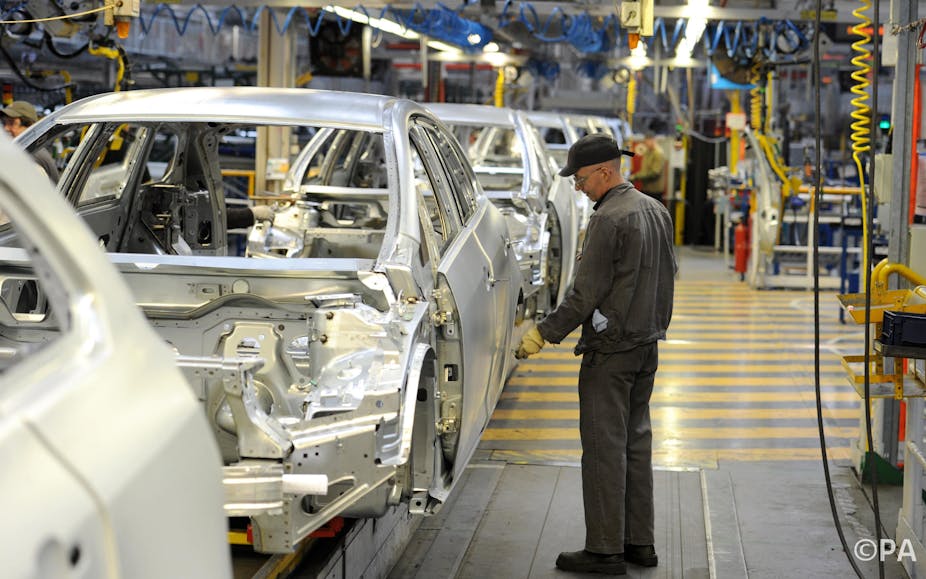In both the US and UK, policymakers have been excited to see a small but significant increase in manufacturing activity and exports. While growth in manufacturing jobs has been sporadic, the creation of skilled manufacturing work has been particularly noticeable in light of major job losses since the early 2000s.
In the US, new manufacturing jobs helped the escape from the long recession. US exports grew 11% in 2010, the fastest growth since 1997, and most of this growth came from manufacturing. In the UK, manufacturing growth has been inconsistent but there have been bright spots in aerospace and autos and in British-brand spirits.
Policymakers, burned by the financial sector meltdown, are now keen to boost the sector. Not only does manufacturing create jobs, it also stimulates innovation and contributes to exports. National and regional governments are attempting to lure production firms with promises of tax incentives and workforce training grants.
Those who support “rebalancing” point to trends in manufacturing firm strategies - in what they need for advanced manufacturing and in how they evaluate different locations. The most important factor in their new calculus is that labour costs represent a smaller portion of total production costs in many industries, while the advantages of market proximity and knowledge resources have increased.
Firms also want to protect the intellectual property embedded in their now globally competitive product lines and to continue to reduce production costs. So, they are looking around for strong information security regimes, a skilled workforce including engineering talent, tax breaks, and subsidies for research and development. They are driving hard bargains in the US and UK, as well as in emerging markets.
A question remains, however, about whether the return of some, now global, manufacturing enterprises will lead to the long-term, sustainable jobs that made them such an important part of the UK and US economies 30 years ago.
There have been broad changes in our economies since the 1980s. Most people tend to associate these changes with the rise of “the banks”, Wall Street, and the City. But the reach of what is being called “financialization” goes far beyond the role of financial services.
We see these changes in the balance sheets of global manufacturing brands such as General Electric, Nestle and Ford Motor Company, who are realising more of their profits from financial subsidiaries and investments. These global mega-firms are nominally in the business of making things, but their earnings, stock valuation and strategies are fixed in financial markets. Their size gives them internal capital markets in which the choice to invest in their manufacturing enterprises is only one of many.
General Electric (GE), for example, generates a huge portion of its revenue from financial services. Its GE Capital division is a major global finance firm offering services through GE Commercial Finance, GE Consumer Finance, GE Equipment Services and GE Insurance. While General Electric overall has many divisions, including in manufacturing, these days it is largely a financial services company.
Manufacturing is, in fact, a weak competitor within these firms; the time line for profits is too long compared to what can be earned through financial transactions. We can see this uneven terrain for manufacturing in declining investment in the necessary elements of the real economy: capital equipment, research and development, and in manufacturing and management skills.
The Information Technology and Innovation Foundation has given us compelling evidence that capital investment in manufacturing has decreased in the US and UK, countering the claim that firms are investing in the production of more specialised products with higher profit-margins.
There are some highly publicised exceptions, such as Tata’s investment in Jaguar Land Rover, but the overall trend in the US and UK has been disinvestment and decline, not transformation via company investment in product and process innovation. Global manufacturers are finding more profitable uses for their capital in finance.
A look at this evidence suggests a difficult prospect for the kind of robust manufacturing industries that would truly re-balance our economies. Although global firms that manufacture products are once again looking at locations in the US and UK, they frequently expect not only tax breaks but that government will pick up the bill for research and development and a skilled workforce. In the end, the level of public investment needed to create a small number of jobs may not meet the cost-benefit test.
Perhaps its time to take a clear-eyed look at the incentives driving global firms away from long-term investments and to face up to the broader role of finance in our economies - and its implications. We might then be able to craft policies that would recreate a real role for manufacturing in our economies.
This is a version of a lecture Professor Christopherson delivered at the University of Birmingham’s Institute of Advanced Studies on 24 September.

